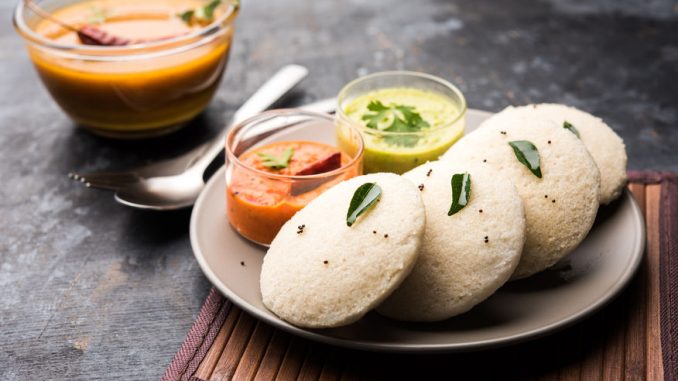
Idli are simple, glorious examples of prudent cooking and there are many reasons to try them or even make them a feature of your cooking.
When you have any breakfast foods or just snacks in southern India or northern Sri Lanka for that matter, then the idli comes into its own as well as good old dosas. Idli is a traditional savoury rice cake with a soft marshmallow or pillow like appearance. That reference to dosa is appropriate because an idli batter is much thicker than that of a dosa’s.
Most Indian restaurants in the UK will now serve idli as a matter of course and in fact it is available any time of the day – lunch and supper.
The earliest recorded writing on them was made in Kannada writings of 920 AD. Modern day idlis are 2 or 3 inches wide and quite fluffy puffed up creations. They are often accompanied with a bowl of chutney or a hot sambar.
Idli is popular throughout the Indian sub-continent. It is mostly made from rice (between 75-80 per cent), black gram (20 – 25 per cent) but also soybean, chickpea and green gram which are substituted for black gram. The rice can be partially substituted with common finger and foxtail millet.
The Fermentation of Idli
Idlis are an interesting fermented food too. It is usually natural although sour buttermilk and/or yeasts are added to enhance the fermentation process. It is described as a mixed auto-fermentation because of the variety of microorganisms involved. It includes Leuconostoc mesenteroides, Lactobacilus delbrueckii, L. lactis along with yeasts such as Saccharomyces cerevisiae. The mixed microorganism culture contributes to the leavening of the batter and to flavour formation. Lactic acid bacteria reduce the pH from 6 to 4.2 which also encourages yeast fermentation. Yeasts also contribute to starch degradation along with carbon dioxide formation for creating the cake and spongy texture. There is also an important production of B vitamins and various free amino acids.
The idli batter has been examined by a number of research groups (Balasubramania & Viswanathan, 2007).
The Idli And The Use Of Black Lentil
You prepare them by steaming a batter composed of fermented black lentils (Vigna mungo) with the husks removed and rice. Indeed, a typical recipe will use 2 or 3 cups of rice, a cup of dehusked or skinless black lentil (black gram or urad daal). Some salt is needed for tasting only and 2 tablespoons of sunflower, canola, vegetable or other frying oil as you would for any batter frying. There’s real simplicity for you!
The key stage incidentally is actually the fermentation of the black lentils which follows after the salt is added. If you cannot ferment black lentils however, look for split black gram dal which is available in Indian supermarkets and add a half to 1 cup to the recipe. The rice and lentils are always washed separately and then soaked overnight.
Preparation Of Idli at Home
We mentioned earlier about preparing a batter which is fermented overnight. When you need idlis for next day’s breakfast or indeed any other time, it is best to begin this part of the preparation right away. The parboiled rice and any rice grains are soaked in 4 cups of warm water along with the pre-soaked split black gram dal. Add a small cup of fenugreek seeds which have been pre-soaked too for two or three hours in a deep bowl.
After 6 hours, the mixture is ground into a fine paste by adding some water in stages. Use a blender. Otherwise grind each component separately and bring together. This becomes the batter!
Transfer the batter to a bowl, add salt to taste and then whip the batter by hand to aerate it.
Set aside overnight for fermentation. If you have a fridge, use it to keep the mixture cool otherwise cover with a clean cloth.
Come the morning, the idlis are best steamed in a pressure cooker the following morning.
If you have an idli tray, use that, otherwise a small cake mould will do. Grease whatever moulds you have with the frying oil or butter.
Pour some batter into each mold to about three-quarters full. The first trials will be a bit hit and miss depending on how wide and deep the moulds are but persevere if you have not used this equipment before. Given that not everyone has a pressure cooker it’s possible to cook the idli in the following manner.
Boil water in a large pot or tray with a covering lid. Place the idli tray into this pot and steam them for 20 minutes. When using a pressure cooker, place the moulds into the water. Ensure the pot or cooker is partly filled to avoid the liquid part spoiling the batter. Steam these idlis for 15 to 20 minutes.
Check the idlis by poking each one with a toothpick. When it comes away clean as you would see for a cake, then it is ready.
Serve piping hot. Serve with your favourite chutney or sambar.
References
Balasubramanian, S., & Viswanathan, R. (2007). Properties of idli batter during its fermentation time. Journal of Food Processing and Preservation, 31(1), pp. 32-40 (Article)
Brill. Take a look at https://www.vegrecipesofindia.com/idli-recipe-how-to-make-soft-idlis/
Really like this idli recipe – simple and not ridiculous like some I see. Even on Youtube it’s impossible to work out what is going on.